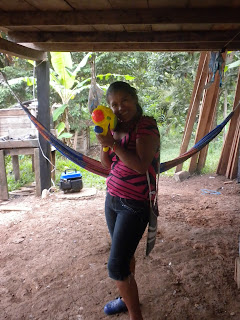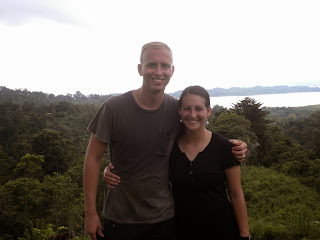As I continue my time in site, I wonder increasingly what
my role is going to be in Quebrada Pastor.
As the third volunteer in this community, I am probably going to be the
last. As a result, it is especially
important that I leave the community with the skills to solve problems and
pursue projects without help. This is a
hard thing to think about.
For example, many people have asked me to provide them
with 1500 gallon plastic tanks to store rainwater or water from the aqueduct
for the times when the source goes dry.
On the one hand, rainwater catchment and storage is a fantastic solution
when there is insufficient water from the aqueduct or no aqueduct exists to
serve a house. On the other hand, simply
giving people plastic tanks does not teach them any skills or how to get the
tanks themselves in the future. What if
a tank breaks? What happens when this
person’s children build their own houses and also want water? So I would prefer to teach people how to
build ferrocement tanks (inexpensive concrete structures that use a concrete
mortar and chicken wire as the reinforcement in tension) so that they can
provide for themselves. But this is
harder, and requires more work, and does not solve the problem of water as quickly
or easily, and is harder to convince people to do. And I think I will face this issue in all
areas of potential projects.
Turn out that these are exactly the kinds of issues that we
face throughout the world. It’s always
easier to just give someone something than to teach them. The persuasion and behavior change – changing
people’s minds and actions – is always harder to developing the
technology. I have this amazing
opportunity to witness all of the problems of the world in this tiny little
microcosm, my own little corner of the universe, small enough for me to live in
and become a part of and pull some strings and experiment, to learn what works
and what doesn’t, so that maybe I can change something, help a little bit, and
then perhaps one day apply that to bigger places.
Figuring out where to begin is the tough part, though. Building aqueducts, tanks, pit latrines,
composting latrines, and trash incinerators; educating about water treatment,
latrine maintenance, hand-washing, disease transmission, waste reduction and
reuse; training water committees and community leaders to do all of the
organization of projects themselves.
And then sometimes wonder to myself if really we should
all just be sexual education volunteers instead, and perhaps we would achieve
more in terms of environmental health. After
all, the staggering population growth is part of the reason so many people in
the community don’t have water in their houses.
After participating in an “Elige Tu Vida” or “Choose Your Life” program
in Zack’s community at the end of October (which deals with setting goals in
life and sexual health for 9th graders – and how these are
connected), I have thought even more about this. I feel like the people in Quebrada Pastor –
and all over rural Panama – would have so many more opportunities (less
poverty, more choices) if girls were not having babies when they were 15 and
women did not spend their entire lives caring for children without really
having the chance to choose (starting with their own babies at a young age, and
having several children, and then caring for their grandchildren). Talking to my host mom, she did not plan to
have a child when she was 16 – but the use of birth control is so limited here,
and there is so little information available to young adults. There’s a lot more that is hard to see in
terms of defined gender roles and the like, but I think I will leave that
discussion for later.
Still working on developing my strategy. We’ll have to see what I come up with.
A narration of some of my other activities from the last
month accompanied by pictures:
Gathering cacao – not the fun part, like cracking them
open – just carrying them, in a bag with the strap on my head to put in this
giant pile.
November is the month of Panamanian holidays – Independence from Spain, and from Colombia, Flag Day, the first cry of independence in Los Santos, Day of the Dead, and every province and/or county declares its own day of independence and has its own celebration. There are parades all the time; these pictures are from Chichica, in the Comarca Ngӧbe-Bugle, where we went for Ngӧbere training. Also got to attend my first birthday party. “Despicable Me” minion for the piñata and everything. And, couldn’t resist attending the Halloween party with the other volunteers at the Regional Leader house in Changuinola. My costume is, uh, me wearing a tiara. Changuinola even set off fireworks! For Halloween! Panama, you're a little strange sometimes.
Been doing more health surveys, with the help of the “Peace Corps Committee” – and maybe having a little bit of fun, too! It’s been interesting seen the wide variety of living conditions throughout the community – and meeting people whose houses I still didn’t know existed (there are about 130 scattered throughout the mountains, I guess it takes me a while to find them all), and who don’t attend my meetings. I have found that sometimes this is because the head of the household is sick; I met one woman who told me that the doctors in Panamá City told her she has cancer. She explained that actually, her ex-husband had put a curse on her and the only way for her to get better was for him to lift the curse. At first I was taken aback – even here, in this community relatively well-exposed to education and the modern world, people still believe in curses? And then I realized that, it may as well be a curse; I don’t know what kind of cancer she has, but there may not be treatment for it, or it may be prohibitively expensive for her.
We had Ngӧbere (the indigenous language in my community) training in Chichica, located in the mountains of the Comarca Ngӧbe-Bugle (semi-autonomous region of the indigenous Ngӧbe and Bugle people; my community consists mainly of Ngӧbe people, but is part of the Bocas province instead of part of the semi-autonomous region) – and I never got tired of seeing Peña Blanca every day for a week. The mountains are just so much more majestic there than in Bocas!! I still like our mountains, rising out of the sea, and I like that there just seems to be more food – and definitely more water – in Bocas, too. Makes life easier. There’s more opportunity for outside employment, too; people can earn money growing cacao (a lucrative cash crop), working in tourism, or for Chiquita Banana. Was definitely interesting to observe the differences.
Of course, it was also interesting to learn some more Ngӧbere, too – since it is primarily a spoken language (the written form was imposed upon the language by linguists and religious groups), the consistency of structure that I have come to expect from language (learned both as a first language in English and later, with more conscious understanding of structure, in Spanish) just does not exist in the same way. This was at times very frustrating. On the other hand, the much more limited vocabulary – especially for expressing complex ideas – in some ways may make the language easier to learn, but in other ways more limiting. I couldn’t help but think of Orwell’s 1984 all week – a limited language limits the ability to communicate, and the ability to think. How does this impact the people who primarily use this language?
We were treated excellently by our host family during training – our host mom even made us shirts! The triangular pattern on the shirts is known as “dientes” or teeth. Legend (and archaeology) contends that the Ngӧbe people used to wear the teeth of their conquered enemies. This tradition is now (thankfully) represented as a pattern on their clothing.
Eric came to visit me in my community and we went for a little hike to see the sea. Always enjoy having visitors! I also got to visit a nearby site – it was a nasty, muddy hike up to Katy’s community, which really made me appreciate living on the road – and respect what she (and many volunteers) has to do to go in and out of her site.
And, of course, I have come to enjoy taking pictures of bugs.

















No comments:
Post a Comment